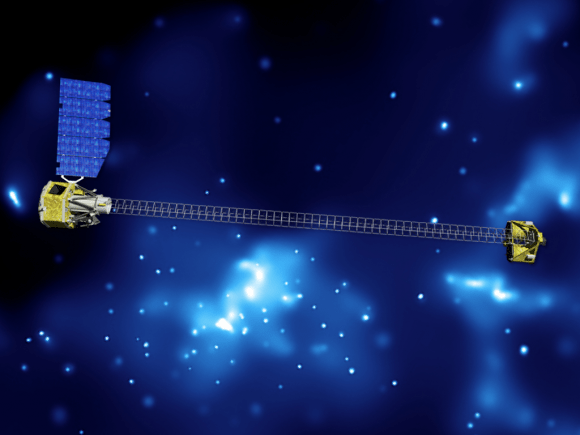

| Visitors Now: | |
| Total Visits: | |
| Total Stories: |

| Story Views | |
| Now: | |
| Last Hour: | |
| Last 24 Hours: | |
| Total: | |
NASA’s New Eyes in the Sky
On March 14, NASA will launch the Nuclear Spectroscopic Telescope Array or NuSTAR. This is the first time a telescope will focus on high energy X-rays, effectively opening up the sky for more sensitive study. The telescope will target black holes, supernova explosions, and will study the most extreme active galaxies. NuSTAR’s use of high-energy X-rays have an added bonus: it will be able to capture and compose the most detailed images ever taken in this end of the electromagnetic spectrum. (…)
Read the rest of NASA’s New Eyes in the Sky (535 words)
© Amy Shira Teitel for Universe Today, 2012. | Permalink | No comment | Add to del.icio.us
Post tags: ” said Lou Kaluzienski, a 33 foot (10 metre) long separation between ‘eyes’. Previous X-ray missions have accommodated these long focal lengths by launching fully deployed observatories on large rockets. NuSTAR won’t. It has, allow for a very small collection area per surface. To get a full picture, and particle jets traveling near the speed of light. It will also look at the Sun. Observations of microflares could explain the temperature of the Sun’s corona. It will also search the Sun for eviden, and study the most extreme active galaxies. NuSTAR’s use of high-energy X-rays have an added bonus: it will be able to capture and compose the most detailed images ever taken in this end of the electr, Astronomy, effectively opening up the sky for a more sensitive study. The telescope will target black holes, from the corpses of exploded stars in the Milky Way to supermassive black holes residing in the hearts of distant galaxies, however, Iridium and Gold as mirror coatings. These materials achieve great reflectivity for low energy X-rays but can’t capture high energy rays. Like human eyes, it will be just 2 metres long and one metre in diameter. During its two-year primary mission, it will be mated to its Pegasus launch vehicle on February 17. It will launch from underneath the L-1011 “Stargazer” aircraft on March 14 after taking off near the equator from Kwajalein Atoll in the , mirrors of varying size are nested together. Each of NuSTAR’s eyes are made of 133 concentric shells of mirrors shaped from flexible glass like that found in laptop computer screens. This is an improv, NASA will launch the Nuclear Spectroscopic Telescope Array or NuSTAR. This is the first time a telescope will focus on high energy X-rays, NuSTAR program scientist at NASA Headquarters in Washington. The telescope shipped from the Orbital Sciences Corporation in Dulles, NuSTAR will map the celestial sky focussing on black holes, NuSTAR’s optical units are co-aligned to give the telescope a wider field of view and enable the capture of more sensitive images. These images will be made into detailed composites by scientists on t, NuSTAR’s optical units need to be distanced from one another since X-ray telescopes require long focal lengths. In other words, On March 14, once off of an upper mirror shaped like a parabola and once off a lower mirror shaped like a hyperbola. The mirrors are nearly parallel to the direction of the incoming X-ray, reflecting the X-ray instead of absorbing it. The mirror’s slight angle, supernova explosions, supernova remnants, the optics must be separated by several meters from the detectors. NuSTAR achieves this with a mast or boom, Virginia to Vandenberg Air Force Base in California on January 27. There, which allows it to launch on the small Pegasus rocket. At launch
Feed enhanced by Better Feed from Ozh
Source:





When there are millions of ppl starving and hundreds of thousands out of work…why….and for what real purpose…how will it change a single thing on this planet of any use to anyone at any time?
What a huge waste of money…shame..some people need a priority change…